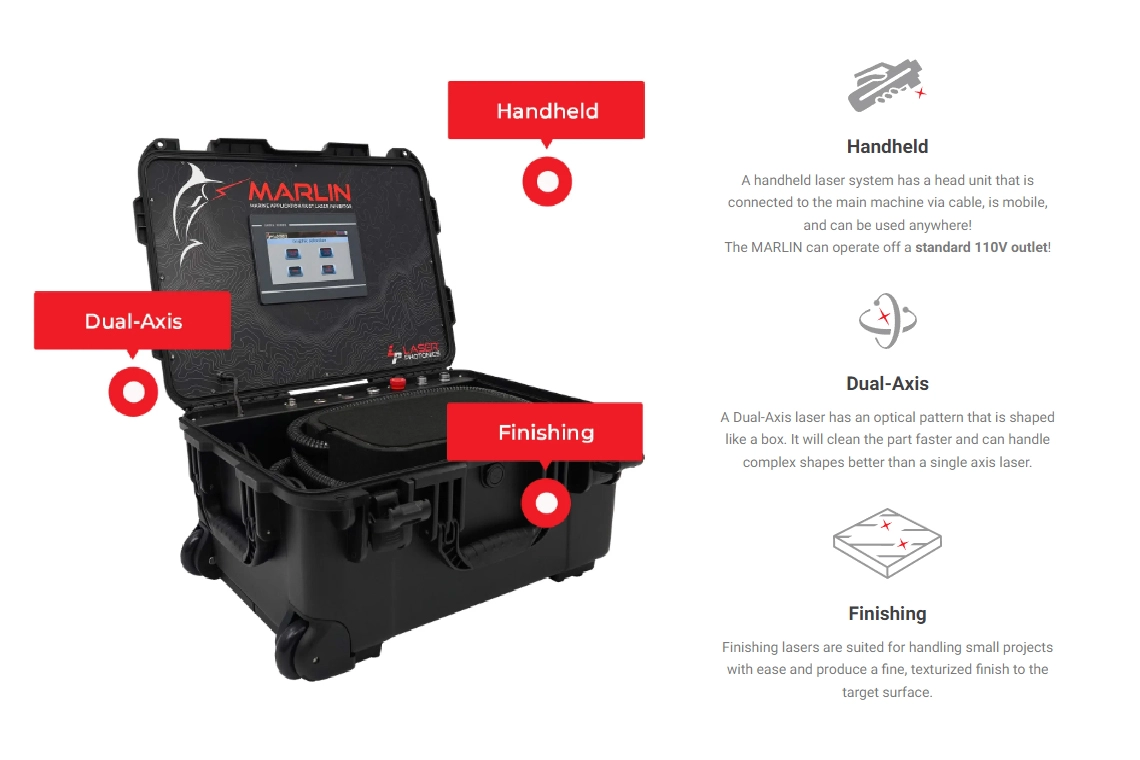Revolutionizing Marine Maintenance
Advanced Laser Cleaning for Enhanced Safety and Efficiency
The Times Are Changing: Adoption of Laser Cleaning
Given such effectiveness, industrial laser cleaning systems are increasingly used at shipyards, shipbuilding drydocks and even aboard ships. Technicians can use mobile handheld units, and laser cleaning technology is one of few suited to shipboard automation, further reducing operating costs, improving cleaning quality, and meeting market demands.The integrity and performance of maritime vessels are vital, but ensuring worker safety is equally important for sustainable maritime and Naval operations. Using power tools for coating removal is labor-intensive and can cause hand and forearm injuries due to repetitive motion.To support shipyard activities and reduce hazards, most private sector employers must follow Occupational Safety and Health Administration (OSHA) standards. The Navy, while technically exempt, voluntarily follows or exceeds many OSHA guidelines.
OSHA’s requirements for abrasive blasting operations include proper ventilation, noise reduction, personal protective equipment, respiratory protection, permissible exposure limits, and safe handling procedures for common media materials.Implementing laser ablation enhances worker health and safety. Unlike sandblasting and power grinding, laser ablation is quieter and requires no force in application. It uses a non-contact method to remove material, which eliminates the need for mechanical tools and greatly reduces noise levels. This improvement leads to better communication, increased worker efficiency, and enhanced safety. Moreover, laser-cleaning technologies reassure workers that their hearing will remain protected.

Health and Safety of Operators & the Environment
Laser Ablation: Enhancing Worker Health and Safety
Noise Reduction:
Laser ablation reduces noise levels, enhancing communication and worker efficiency.
Elimination of Mechanical Tools:
Removes the need for mechanical tools, reducing the risk of hand and forearm injuries.
Environmental Impact:
Minimizes environmental impact, aligning with strict regulations to protect human health and the environment.
Duty to Protect
Acknowledgment of Responsibility:
Both the maritime and Naval sectors acknowledge their duty to protect the environment and safeguard human health.
Strict Regulations and Guidelines:
Enforced to ensure proper handling and disposal of hazardous waste.
Rising Environmental Standards:
As national environmental protection standards rise, more attention is given to the health and safety of construction workers.
Inadequacy of Traditional Technologies:
Traditional cleaning technologies have become inadequate for the modern shipbuilding industry, creating an urgent need for new cleaning technologies.

Benefits of Laser Ablation
Single-Step Process:
Removes both surface contamination and paint simultaneously, reducing a multi-step process to a single step.
Decentralized Cleaning:
Saves transport through decentralized cleaning and reduces masking effort.
Versatility:
Works on all surfaces prone to rusting, including iron, aluminum, composites, and copper.
Energy Efficiency:
Reduces energy consumption, saving valuable resources in both production and maintenance.

Higher ROI with Laser Cleaning
Preparation and Cleanup Time:
Laser-based cleaning systems reduce the time required for preparation and cleanup, significantly affecting project costs.
Enhanced Operator Safety:
Improved safety for operators, leading to longer equipment lifespan and reduced maintenance needs.
Durability:
Laser systems are durable, making replacements unnecessary for decades and requiring virtually no maintenance after purchase.
Regulatory Scrutiny on Traditional Methods
Risks of Sandblasting and Chemical Stripping:
Draw scrutiny from regulators like the EPA and OSHA due to risks to applicators and the environment.
Health Hazards:
Silica sand used in abrasive blasting can cause serious or fatal respiratory disease when inhaled.
Feasibility Issues:
Traditional methods may not be feasible for cleaning, maintaining, or reconditioning many of a vessel’s interior and exterior spaces.

Technological Advancements and Cost Efficiency
With ongoing technological advancements, the cost of laser cleaning equipment is steadily decreasing, while the hidden costs of traditional cleaning methods are rising. Increasing governmental environmental protection requirements and penalties for heavily polluting enterprises also play a role.
Transforming Marine Maintenance
LPC’s MARLIN laser cleaning technology represents a significant shift in marine maintenance, offering a safe, efficient, cost-effective, and environmentally friendly solution to the persistent issues of corrosion, biofouling, and surface preparation. This innovative approach is transforming the surface treatment market across various sectors. By adopting MARLIN, decision-makers in the maritime and naval industries can achieve unprecedented levels of operational efficiency, sustainability, and safety. To learn more about how LPC’s laser cleaning technology can benefit your operations, visit our website or contact us to schedule a demonstration.To learn more about how LPC’s laser cleaning technology can benefit your operations, contact us to schedule a demonstration today!